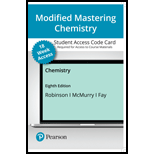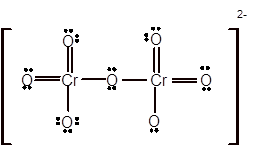
Concept explainers
(a)
Interpretation:
The electron dot structure of
Concept introduction:
Lewis dot structure is the representation which shows the bonding between atoms present in a molecule. It shows lone pairs and bond pairs that exist on each bonded atom.
Lewis dot structure is also known as Lewis dot formula or electron dot structure. The bond formation between the atoms takes place due to the sharing of valence electrons of bonded atoms while the remaining electrons present in outer shell represented as lone pair of electrons. To draw the Lewis structure, calculate the total number of valence electrons in each atom and draw the structure in such a way that each atom gets its octet configuration.
Formal charge on each atom can be determined with the help of number of valence shell electrons, number of lone pair electrons and bond pair electrons. The formula for the formal charge can be written as:
(b)
Interpretation:
The number of outer-shell electrons in each Cr atom in the electron dot structure needs to be determined.

Concept introduction:
Lewis dot structure is the representation which shows the bonding between atoms present in a molecule. It shows lone pairs and bond pairs that exist on each bonded atom.
Lewis dot structure is also known as Lewis dot formula or electron dot structure. The bond formation between the atoms takes place due to the sharing of valence electrons of bonded atoms while the remaining electrons present in outer shell represented as lone pair of electrons. To draw the Lewis structure, calculate the total number of valence electrons in each atom and draw the structure in such a way that each atom gets its octet configuration.
Formal charge on each atom can be determined with the help of number of valence shell electrons, number of lone pair electrons and bond pair electrons. The formula for the formal charge can be written as:
Want to see the full answer?
Check out a sample textbook solution
Chapter 7 Solutions
CHEMISTRY-MOD.MASTERING (18W)
- The proportion of O, C and H in the graphite oxide is constant, only the cantidades of functional groups of acids, phenols, epoxy, etc. its constants. ¿Is it correct?arrow_forwardThe proportion of O, C and H in the graphite oxide depends on the structure of the graph that is processed, which may be more tridimensional or with larger crystals, or with smaller crystals and more borders. ¿Is it correct?arrow_forwardIn mixed oxides with superconducting properties, we find Cu:a) Frequentlyb) Alwaysc) Almost neverarrow_forward
- The proportion of O, C and H in the graphite oxide depends on the preparation method, as long as the most oxidant, the most graphite is destroyed and has less O. Is it correct?arrow_forwardWrite the complete common (not IUPAC) name of each molecule below. Note: if a molecule is one of a pair of enantiomers, be sure you start its name with D- or L- so we know which enantiomer it is. molecule C=O H3N CH3 common name (not the IUPAC name) H ☐ C=O H O-C-CH2-CH2 010 NH3 ☐ H3N ☐ HO 5arrow_forwardWrite the systematic name of each organic molecule: structure CI CH3 HO-C-CH-CH-CH2 – CH— CH3 CH3 name X O ☐ CH3-CH-CH2-CH2-C-OH CH3 11 HO-C-CH-CH2-OH CH3 ☐arrow_forward
- Check the box under each a amino acid. If there are no a amino acids at all, check the "none of them" box under the table. Note for advanced students: don't assume every amino acid shown must be found in nature. CH3 CH2 0 C=O + CH-CH3 H₂N C-COOH H₂N H H H3N C COO¯ NH, O HO C C H CH3-CH HO C=O H2N-CH-COOH CH2 NH3 HO CH3 none of them O NH3arrow_forwardhandwritten answer please!arrow_forwardConsider the following SN 2 reaction: مار + Br H₂O acetone + Br OH What effect would each of the following changes have on the rate of this reaction. Select the single best answer for each part. Part 1 of 3 If the substrate was changed to: The rate would Br O increase O decrease O remain unchanged Part 2 of 3 × S If the nucleophile was changed to OH, the rate would: O increase O decrease O remain unchanged Part 3 of 3 If the solvent was changed to ethanol, the rate would: Increase O decrease O remain unchanged 2 ol Ararrow_forward
- Consider the following nucleophilic substitution reaction. The compound listed above the arrow is the solvent for the reaction. If nothing is listed over the arrow, then the nucleophile is also the solvent for the reaction. Part: 0/2 Part 1 of 2 Br acetone + I What is the correct mechanism for the reaction? Select the single best answer. OSN 1 OSN 2 X Part: 1/2 Part 2 of 2 Draw the products for the reaction. Include both the major organic product and the inorganic product. If more than one stereoisomer is possible, draw only one stereoisomer. Include stereochemistry where relevant. Click and drag to start drawing a structure. Х 5 ☐arrow_forwardTriethyloxonium tetrafluoroborate reacts with ethanol (CH3CH2OH) to give diethyl ether (CH3CH2OCH2CH3). BF triethyloxonium tetrafluoroborate Which equation, including the curved arrows, best represents the rate-determining step in the mechanism? Select the single best answer. O OH CH3CH2 OH + H. 0+ CH₂H₂ :0 + 0+ ж + H + :0: 0 Carrow_forwardCH3CH2CH=CH2 + H₂O − H+arrow_forward
 Chemistry: Principles and ReactionsChemistryISBN:9781305079373Author:William L. Masterton, Cecile N. HurleyPublisher:Cengage Learning
Chemistry: Principles and ReactionsChemistryISBN:9781305079373Author:William L. Masterton, Cecile N. HurleyPublisher:Cengage Learning Chemistry: The Molecular ScienceChemistryISBN:9781285199047Author:John W. Moore, Conrad L. StanitskiPublisher:Cengage Learning
Chemistry: The Molecular ScienceChemistryISBN:9781285199047Author:John W. Moore, Conrad L. StanitskiPublisher:Cengage Learning Chemistry & Chemical ReactivityChemistryISBN:9781133949640Author:John C. Kotz, Paul M. Treichel, John Townsend, David TreichelPublisher:Cengage Learning
Chemistry & Chemical ReactivityChemistryISBN:9781133949640Author:John C. Kotz, Paul M. Treichel, John Townsend, David TreichelPublisher:Cengage Learning Chemistry & Chemical ReactivityChemistryISBN:9781337399074Author:John C. Kotz, Paul M. Treichel, John Townsend, David TreichelPublisher:Cengage Learning
Chemistry & Chemical ReactivityChemistryISBN:9781337399074Author:John C. Kotz, Paul M. Treichel, John Townsend, David TreichelPublisher:Cengage Learning
 ChemistryChemistryISBN:9781305957404Author:Steven S. Zumdahl, Susan A. Zumdahl, Donald J. DeCostePublisher:Cengage Learning
ChemistryChemistryISBN:9781305957404Author:Steven S. Zumdahl, Susan A. Zumdahl, Donald J. DeCostePublisher:Cengage Learning





